Ripeti Con Me! Review: Glossika Improvement Or Poor Imitation?
 Written byHubert Nagel
Written byHubert Nagel- Read time18 mins
- Comments8
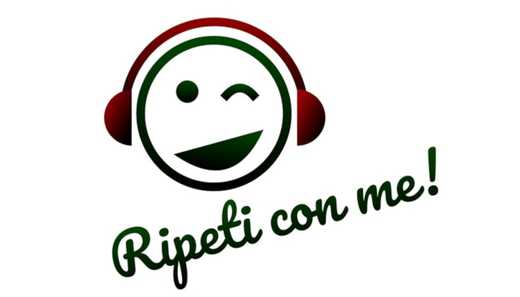

- High quality Italian recorded sentences
- Structured by topic
- Downloadable content
- Glossika imitation
- Slow audio
Ripeti Con Me! aims to build on and “improve” Glossika’s method. Its founder, Stefano Lodola, is personally fond of the Glossika approach but he saw issues in the Italian version that he hoped to improve with Ripeti Con Me!.
I was recently contacted by Stefano Lodola, an Italian native, polyglot and language coach who runs a site called Fluent. Simple.
He created an Italian course called Ripeti Con Me! (Repeat With Me!) which he sent me partial review access to (the first 15 lessons) so I’m going to share some of my own insight after spending some time with it.
There are quite a lot of good Italian resources around (also see this Italian course list, Italian app list and this Rocket Italian review for example).
But it’s always refreshing to see attempts at trying new things.
Ordinarily, I wouldn’t review an item on a whim if I’ve never previously heard of it, but given the fact that Ripeti Con Me! attempts to use a very a Glossika-esque approach (of which I’m a fan), I was curious to take a closer look at it and see how it compares to Glossika Italian.
Since I’ve only seen the first 15 lessons, I should emphasize that I’m unable to speak comprehensively on the depth of the entire course and higher levels here.
I’d estimate that I’m personally around an A2 level in Italian (I lived in Sondrio after my Russia stint and frequent the area), meaning that it’s a little hard to put myself in the shoes of a totally brand new learner of Italian using the program without any prior knowledge.
But hopefully this review this gives you some idea of the Ripeti Con Me! content and method.
NOTE: I reached out to Stefano with some questions to which he gave some detailed responses. You’ll find these Q&A’s at the bottom of this article (there are also some comments of his throughout the review).
Used Ripeti Con Me! before?
Share your experience below.
Innovation vs. imitation in language products (and does it matter?)
Oftentimes, you come across new language courses and products and it’s clear that they’re a clone or spin-off of something else.
Ripeti Con Me! doesn’t hide the fact that it’s trying to build on and “improve” Glossika’s method.
It seems clear that Stefano Lodola is personally fond of the Glossika approach (he shares this opinion on his website) but he saw issues in the Italian version that he wanted to rectify.
Here are some of the main (perceived) issues with Glossika Italian that Stefano draws attention to:
- Native Italian speakers talk too fast
- English and Italian sentences/translations don’t always match
- Glossika uses a regional Italian accent (I wish he’d expand on this further and why it’s important)
- Unnatural or awkward Italian sentences
- Inadequate pauses between Glossika sentences
- Sentences are too long
Ripeti Con Me! attempts to iron out these points and provide an improved Glossika derivative made by an Italian for learners of Italian (see my important comment on this below).
After some research, I found numerous comments online from Stefano that do indeed confirm that Ripeti Con Me! was motivated by and intended to follow the Glossika method.
From Reddit:
Only if you study Italian, I can recommend “Ripeti con me!”. I made it so I’m biased, but you can still check out the free preview on my website and judge for yourself.
My intent was to keep the method and fix those flaws.
I consider it an improved version of Glossika. It also happens to be more affordable.
I’m not sure how I feel about this, to be honest.
First of all, I don’t have an issue with building on and improving existing concepts – especially if the original concepts had room for improvement.
Many great innovations have been built on other people’s ideas.
But it’s still an ethical gray area for me.
It’s almost impossible to patent or trademark ideas and methods (something I have personal experience trying!), so there’s technically nothing stopping someone from “keeping the method” and creating something else with it.
But I know that Mike Campbell (Glossika’s founder) has spent decades using, improving and promoting his method.
It’s not a whimsical course that he put together overnight.
Speaking from personal experience, it frankly sucks when you put years of thought and love into an idea, only to have someone come along and reappropriate it (I’ve had this happen to me several times and it’s a crushing feeling).
Even if they’ve made it better.
This is why I often get frustrated with companies that put a fresh coat of paint on existing software and market the hell out of it (e.g. Babbel which very clearly emerged as an attempt at cloning Rosetta Stone).
I even wrote a whole article on the topic.
So while I admire that Ripeti Con Me! has been very clear and forthright about building on the concept of Glossika, the issue for me is whether or not it’s sufficiently unique and innovative.
What does Ripeti Con Me! provide?
Glossika was originally (may still be — I’m not sure) a book publisher.
The Glossika method came as either a printed booklet or a PDF with MP3 audio files of all the recorded sentences.
I made use of the Russian book when I lived in Russia.
As I said in my Glossika review, the company then moved toward a SaaS business model a short while ago, turning its books and audio into an interactive web app.
It’s the same identical course, content and method but with a gamified app that records progress and skills.
Ripeti Con Me! is packaged the same way as Glossika was originally.
You receive a PDF booklet of all the lessons and sentences (Italian with English translations underneath), and a collection of MP3 files (3 files — a, b and c — for each lesson).
There’s also another PDF that explains how to use it all.
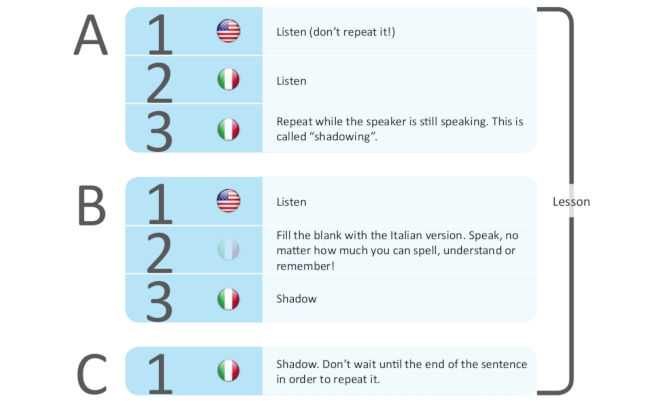
The MP3 files are designed like this:
A: English is spoken. Italian translation given and repeated. No pause.
B: English is spoken. Pause given to allow you to translate. Italian translation spoken once.
C: Italian only.
The individual steps are laid out in the PDF instructions.
Interestingly, Stefano uses something called shadowing which I’ve talked about before.
This is something that’s done in simultaneous interpretation (where you’re interpreting as the native speaker is talking).
Shadowing is also used as a training exercise for people learning to simultaneously interpret.
It’s one of the more challenging activities you can do as a polyglot as it requires detailed attention to and comprehension of what you’re hearing while at the same time producing accurate interpretation in another language.
Course structure – where Ripeti Con Me! seems to completely diverge from Glossika
People often remark that Glossika seems to be just a random collection of sentences that don’t seem to make a whole lot of sense together.
You get asked to repeat sentences like this one:
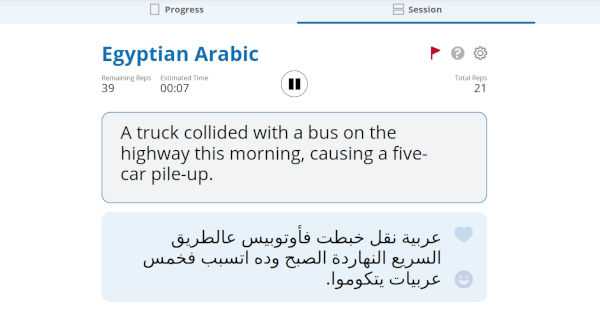
Mike Campbell has talked a lot about the overall course and syntactical structure of his “sentence training”.
He discussed this at length in my Glossika review and interview.
He’ll also use terms like “algorithm” to explain how he’s worked out appropriate syntactical patterns to repeat.
I think the precise details of this are still a bit of a mystery.
Ripeti Con Me! seems to diverge completely from what Glossika does.
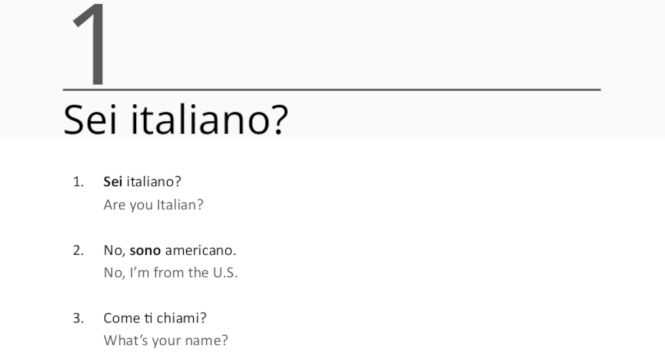
I went through the 15 lessons I was sent and was easily able to spot the patterns and grammar focus of each lesson. For example:
Lesson 1: Sei Italiano?
Most of the sentences here use patterns that include the verb ‘to be’. (I am, you are, he is, etc.)
Lesson 2: Ho sete!
These patterns show ‘to have’.
Lesson 3: Un gelato, due gelati
Singular and plural endings. Number agreement.
I think this is the most important point in terms of any comparison between the two programs.
Glossika has its own way of implicitly introducing these syntactic patterns.
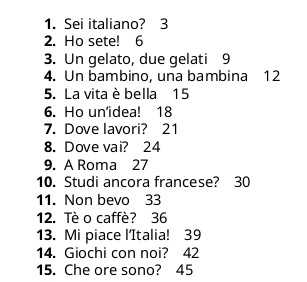
Ripeti Con Me! is much more explicit.
So even though Ripeti Con Me! does not introduce a lesson saying, “Today we’ll look at how to say ‘you have’ something in Italian”, it’s pretty clear from a cursory glance what it’s trying to teach you.
Whether or not one is better than the other is no doubt subjective.
My only question is ‘what differentiates Ripeti Con Me! from simply extracting lesson sentences straight out of a grammar book?’
Comment from Stefano on this:
You could say the same about Glossika or any app like Babbel, Busuu, etc.
Anyway, a grammar book doesn’t prompt you to speak; doesn’t come with audio or automatically play it; orders units as in a catalog, not as tools to communicate; sentences are chosen to showcase grammar and don’t aim for communication (conversation).
Sentences in a grammar book are limited and only make sense if accompanied by grammar notes in another language, which disrupts the native immersion effect.
The audio is definitely slower and clearer in Ripeti Con Me! — Glossika is quite fast (natural speed).
Not being an expert or high-level speaker of Italian, I wish I could comment on the dialect or accent differences between the two but I do know that for some language editions, Glossika has been known to hire speakers with obscure/regional accents.
This is not always a problem necessarily but it needs to be stated clearly.
Pricing differences between Glossika Italian and Ripeti Con Me!
Like I said, Glossika moved over to a SaaS model so they provide a monthly subscription.
This works out to be $30 a month or about $25 a month if you pay annually up-front.
Ripeti Con Me! is a once-off downloadable purchase.
For the 15 absolute beginner lessons I got to try out, you’d pay EUR14.40.
For the entire collection, it’s EUR91.80.
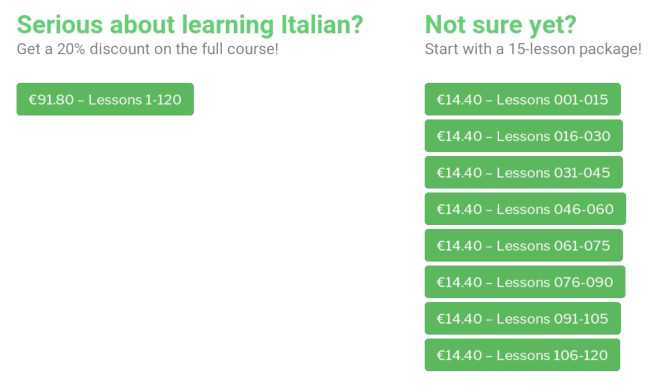
Obviously more steep up-front but the advantage is you’re not paying for a subscription.
Benefits of getting a subscription service: progress tracking, access to all languages, constant updates and improvements, control over intervals, speed and ability to record your own voice.
The obvious disadvantage is that you don’t technically “own” what you paid for.
Sometimes it’s just nice to be able to put your MP3’s onto a portable device and play without having to log in to a site.
Native speakers don’t always know what’s best for learners
I thought I’d share a timely article/video that just came out on the I Will Teach You A Language blog.
Olly raised a pertinent point about native speakers and how they’re not always the best teachers of their own language. I’ve been saying the same thing for years.
Just because you speak a language natively, doesn’t mean you know how to teach it.
Important: a native speaker doesn’t necessarily know the struggles that learners are facing.
Comment from Stefano:
So, any study material made by a native speaker is worthless? Ironically, one of Glossika’s biggest flaws is that it copies sentences from English into every language, with no heed for the characteristics of each language. On the contrary, I designed my course for the Italian language. I wrote English sentences that reflect the Italian ones, not the other way around.
Sure, if you randomly stop passers-by in the street in Italy with no teaching or learning experience and ask them to teach you Italian or write a language course, they would be clueless. But I happen to have learned 10 foreign languages and taught 1,000+ Italian classes. So, that’s not the case.
I’ll tell you more.
I only teach Italian because I believe that the ideal teacher is a native speaker with teaching and learning experience. I know many language teachers who barely speak one native language and I always wonder what they know about how to learn a language.
I’ve seen this countless times with Arabic.
Native speakers are often clueless when it comes to learner issues.
I thought this was timely advice as I was looking at Ripeti Con Me! and contemplating the exact same thing – Stefano sought to correct Glossika’s method from the perspective of a native speaker (which may or may not be directly relevant to learners of Italian).
Does this necessarily apply to Stefano and Ripeti Con Me!?
Not necessarily. Maybe.
I don’t actually know anything about Stefano Lodola in terms of his teaching experience (UPDATE: See his response below).
What I can say is that regardless of the method that Ripeti Con Me! uses, the sentences themselves are a valuable resource and could be a great listening resource on their own.
Being as inexpensive as it is, I would certainly use it (I personally recommend using its content for high-repetition listening as I demonstrated here).
Final comment from Stefano on my review:
I have the impression that you’re giving me a “market follower penalty” only because my product is an improvement of an existing product and you don’t find it a noble way to do things.
However, I’m not copying Glossika. I only applied its method in a better way. Compared with the old Glossika, mine is superior under every aspect. I know that because I’ve used Glossika for several languages and they all share the same flaws.
Even if you compared it with the new Glossika app, my course is certainly less sophisticated, but not necessarily worse. In fact, I still prefer the old Glossika to the new app, and to any app in general. Apps are flashy with their animations and the fanfares at the end of every unit, but if they don’t prompt to speak, they miss most of the benefits. Besides, it’s easy to get distracted by notifications, to take breaks “to keep your own pace”, etc.
Not to mention that we learn better by listening with no text as a visual aid first.
Both the authors of Pimsleur and Glossika state that, but then they all jumped on the app train because it’s more attractive in the eyes of the casual learner.
In response to this response, I should add that I’m not giving Ripeti Con Me! a “market follower penalty”.
I don’t necessarily rate products based on their originality. I’m more interested in their results.
Although I made mention of the ethical question I personally have concerning building on another company’s idea, this does not have any bearing on whether or not I think Ripeti Con Me! is an effective course.
Interview responses from Stefano Lodola, creator of Ripeti Con Me!
I received some great responses back from Stefano to some questions I asked which I’ll post here.
1. Who is Stefano Lodola? Tell us about your education and experience as a polyglot.
I was born and raised in a small town in Tuscany, Italy, speaking only Italian.
I always liked learning languages at school (English and French), but certainly those classes weren’t making me fluent.
My first linguistic endeavor as an independent language learner was Japanese when I was 16. It felt like a totally new world and took several years to learn.
Since then, language after language, I refined my methods. In fact, I rely on language learning products less and less, but rather go speak with natives on Skype from Day 1.
I don’t have any formal training in teaching or linguistics.
At university, my majors were engineering and business administration, following the suggestion that “you should have a major, while languages are a plus”. Yeah.
During the last few years, I made a living teaching Italian online, doing translations, and singing as a tenor, among other.
I teach Italian the same way I learn other languages myself: little or no grammar notes, a lot of examples, trial and error. One hurdle is that the average casual language learner is used to the methods they followed at school.
That’s why I made a language coaching course on Udemy to show how I actually learn languages.
I’ve taught 1,000+ classes online. I’ve also taught in person for a couple of months in a language school in China, but those were group classes, and it was regrettable to know that the way you’re doing things is not the best.
As a learner, I only take 1-on-1 classes, thus I want to do the same as a teacher, too.
2. What makes Ripeti Con Me unique?
When my Italian students asked me for learning resources, I’d recommend Pimsleur to beginners and Glossika to lower-intermediate speakers and above. I believe that speaking is paramount to learn a language, and these audio courses get you to speak.
However, mine was a half-hearted recommendation, because, as a user of those products myself, I was aware of their flaws.
Then I thought, why should my students settle for second bests? Can’t I make a better one? And I started to work on Ripeti Con Me.
In fact, I didn’t need to reinvent the wheel. Glossika’s method is sound. It only needed a better application.
90% of what makes Ripeti Con Me unique is also what makes Glossika unique, especially the old audio version of it. You push “play” and get to practice listening and speaking every day.
No frills or distractions.
You stick with Italian with no guidance in English other than the sentence translation.
3. You and others have compared Ripeti Con Me to Glossika. Explain this comparison and why Ripeti Con Me is better for an Italian learner.
The other 10% that makes Ripeti Con Me unique is the “improvement” on Glossika Italian: human speech rate and intonation (Glossika was fast even for a native speaker and the speakers sounded like robots), bolded text to focus on the new grammar pattern, shorter and fewer sentences per lesson, more practical sentences, longer learning tree to take time to review past lessons, ease to use (a, b, c, repeat)…
Above all, this course is specifically designed for the Italian language (Glossika had one master script in English and translated that in every language, which ignored entire aspects of other languages and resulted in sentence mismatches).
4. You say Ripeti Con Me “follows a grammar plan shared by most textbooks”. Can you explain this in more detail?
There’s plenty of language courses (textbooks, audio lessons, apps, etc.) that introduce new grammar following what is commonly accepted as the natural order.
For example, we all learn the present tense of verbs before the past tense.
Again, I didn’t need to invent anything. I took a couple of Italian textbooks as references and the backbone of the course program was ready.
However, I did more than that.
I broke down textbook units into lesson clusters, for example, I split the unit on the present tense into one lesson for regular verbs and one for irregular verbs.
This way, exposure to grammar is gradual and there’s time to review patterns from other lessons. In fact, the entire course is padded with lessons on topics that usually don’t make an independent unit in language courses. For example, there’s one lesson on how to use the word “perché”, meaning “why” or “because”.
While the focus of the lesson is that single word, you’re still reviewing the present tense that you just learned in the previous lessons.
By the way, there are language learning products that don’t even have a plan, like Languagepod101. They’re just a bunch of lessons grouped by level.
That’s ok as a complementary material, but there’s no course without a plan.
5. Can you share any success stories from Italian learners so far following your method?
Some of the users of Ripeti Con Me learn Italian with me on Skype and practice speaking with my audio course between classes.
Those who practice daily improve their speaking skills faster than those who don’t or do other activities like reading or playing with language learning apps.
They are the most motivated and disciplined of my students.
6. Does Ripeti Con Me use a specific regional dialect or pronunciation of Italian?
I’m both the author and the speaker of my course.
I strive to speak without a regional accent. This is quite natural to me because I don’t have a regional accent and I don’t speak any dialect. In fact, Italian people can’t guess where in Italy I’m from.
The diction course I took when I was in college and my vocal training as a tenor certainly helped me reach a standard pronunciation.
Used Ripeti Con Me! before?
Share your thoughts below.
 Grab the link to this article
Grab the link to this article